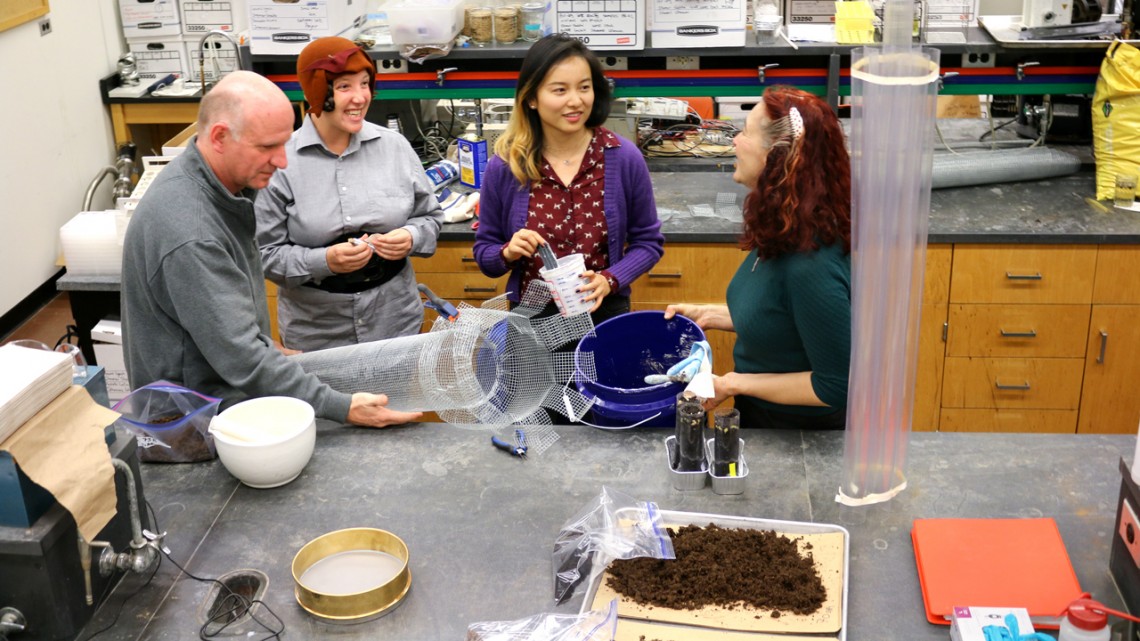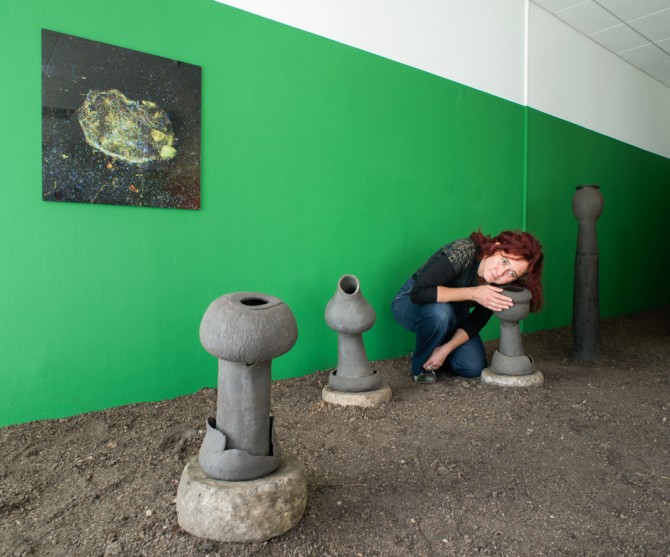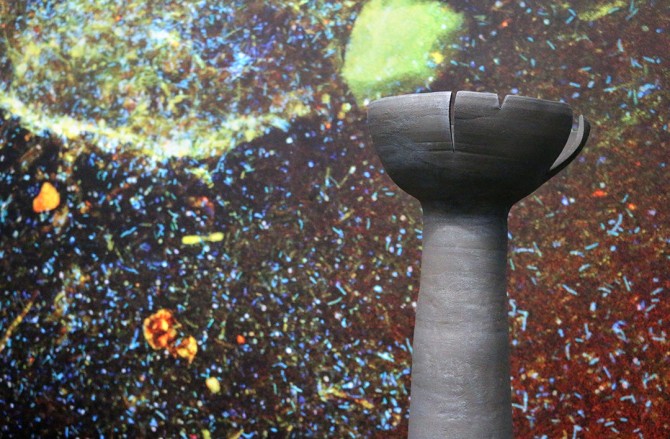
Professor Johannes Lehmann with KAR Robison ’20, graduate student Shiyi Li and artist Karine Bonneval in the soil lab in Bradfield Hall, preparing wire mesh forms for an art installation on the Ag Quad.
Art and science provide fertile ground for research, teaching
By Daniel Aloi
For Johannes Lehmann, serendipity, curiosity and collegial conversations on two continents have led to a pair of multidisciplinary research collaborations involving sound and soil – with inspiration and assistance from an artist.
“I remember having a conversation with a French artist in Berlin who was working on a sound installation to investigate the sounds of soil,” said Lehmann, professor of soil and crop sciences in the College of Agriculture and Life Sciences (CALS). “She asked, ‘Is soil really silent? Or are there sounds? Surely there are animals making sounds. Has anyone listened to the soil?’”
Back in Ithaca, he met with researcher Holger Klinck, director of the bioacoustics lab at the Cornell Lab of Ornithology. “I presented this kind of provocative thought here and invited people from across the university,” Lehmann said. “I’ve been a soil scientist for 30 years, and I’ve never thought about what sounds the soil makes. It’s the greatest biodiversity on Earth, and it’s something we wanted to follow up on.”
Lehmann and Klinck sounded out two other Cornell scientists – associate professor of entomology Kyle Wickings and assistant professor of civil and environmental engineering Greg McLaskey – to join in a project to listen to the Earth. Wickings is the principal investigator on “Sounds of Soil,” a project to develop inexpensive acoustic sensors to detect, monitor and study populations of soil-dwelling organisms – in particular, disruptive insects that feed on roots, affecting both plant and soil health. The project received a Venture Fund grant from the Cornell Atkinson Center for Sustainability in June 2018.
The artist Lehmann met in Berlin, Karine Bonneval, is on campus for a residency with Lehmann until Nov. 17 and will discuss her work in a public lecture Oct. 28 at 5:15 p.m. in Milstein Auditorium. She will have an art exhibition Nov. 10-16 in the Experimental Gallery in Olive Tjaden Hall, with an outdoor art installation on the Ag Quad that she is building with students Kimberly Garcia ’22; Shiyi Li, M.P.A.’15, M.S. ’18; and KAR Robison ’20.
Bonneval has worked with scientists since 2014 to develop collaborative projects focused on trees and plants and their environments, combining research and creation. In her public lecture, she will discuss projects including “Listen to the Earth,” with Lehmann and biologist Matthias Rillig from Berlin, based on recent research on linkages between sound, soil, plant root behavior and fungi.
The three have co-authored a paper published in Soil Systems, “Sounds of Soil: A New World of Interactions Under Our Feet?” that introduces sound equipment to soil research and investigates whether biota tap into “sound, particularly vibrations, as a source of information,” e.g., between plants and microbes. Sound is just one avenue of communication and connectivity in a realm where chemical information moves freely and vast fungi networks are abundant.
The work from both projects will have implications for biodiversity monitoring and managing agricultural insect pests.
Art is no outlier in Lehmann’s scientific world; he currently co-teaches the Environmental and Sustainability Sciences colloquium with Verity Platt, professor of classics and the history of art in the College of Arts and Sciences. The class “introduces students from the environmental sciences major in CALS and Arts and Sciences, and the wider university, to the humanities view of environmental problems and sustainability,” Lehmann said.
He recalled when redesigning the course about five years ago, “I said, ‘Let’s invite artists, curators, poets, people in the performing arts, theater, to provide their view on sciences and the environment.”
The three-credit option for the course is included in the new environmental humanities track within the major, Platt said.
“It’s a very inspiring and exciting learning process,” she said. “It’s mostly science students, and they’re very open-minded and ready to get into discussion. I am definitely learning from them as much as they are learning from me. They have impressed me with their subtle responses to fiction, essays, poetry, landscape painting and film. They’re very brave and full of ideas.”
Discussion topics have included trees and the “wood-wide web,” indigenous concepts of knowledge and place, environmental issues in contemporary fiction, and climate crisis in the visual arts.
“It’s really quite radical for scientists and humanists to be exploring these things together,” Platt said. “Eco-criticism is a rapidly developing field that is attracting a lot of interest in the humanities right now.”
Two years ago, the instructors invited Bill Gaskins, then a professor of art at Cornell, to give a lecture. “He didn’t even really talk about science, but about how he came to think about creativity,” Lehmann said. “It was truly eye-opening. As an emerging professional artist, he [said he] had to think hard to come up with new formal language and new questions to ask.
“I thought about how we learn and how we conduct science,” Lehmann said. “Bill discussed his very earnest way of thinking about creativity, and I thought about the students who understood his message. There was some fertile ground there.”
Lehmann and Gaskins met several times afterward and discussed the links between these different modes of inquiry, leading to a co-authored paper on scientific creativity. The paper argues for universities establishing an institutional framework for “transformative creativity,” and considers factors including the role of critique in the artistic and scientific process.
“We don’t like to err, and we’re not giving that enough space, to err and document the errors we make,” Lehmann said. “This is something that leads us in a completely different direction. There’s quite a lot of beauty in that error. It’s an ongoing discussion, I think, about how we make this cross-disciplinary learning and inspiration happen.”
Media Contact
Get Cornell news delivered right to your inbox.
Subscribe


